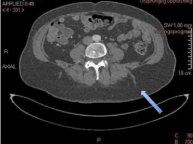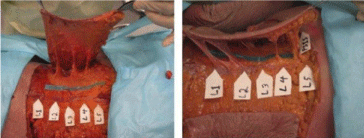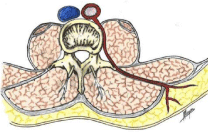Research Article
The Anatomical Basis of the Lumbar Artery Perforator Flap: A Cadaveric and Computer Tomography Angiogram Study
Lorenzo Calì-Cassi1*, Shai M. Rozen2, Maria Mani1, Thorir Audolfsson1, Gangadasu Reddy2 and Andres Rodriguez-Lorenzo1
1Department of Plastic and Maxillofacial Surgery, Uppsala University Hospital, Sweden
2Department of Plastic Surgery, UT Southwestern Medical Center, USA
*Corresponding author: Lorenzo Calì Cassi, Department of Plastic and Maxillofacial Surgery, Uppsala University, 751 85, Uppsala, Sweden
Published: 28 Dec, 2016
Cite this article as: Calì-Cassi L, Rozen SM, Mani M,
Audolfsson T, Reddy G, Rodriguez-
Lorenzo A. The Anatomical Basis of
the Lumbar Artery Perforator Flap: A
Cadaveric and Computer Tomography
Angiogram Study. Clin Surg. 2016; 1:
1270.
Abstract
Background: Lumbar skin flaps based on cutaneous perforators arising from the lumbar artery have been described for coverage of lumbosacral defects and as free flaps for autologous breast
reconstruction. Thus, the purpose of this study is to clarify anatomical aspects of the lumbar artery
perforator flaps pertaining improvement in utility and design of this flap.
Methods: Five fresh human bodies were dissected and twenty three-dimensional computed
tomographic (CT) angiographic previously used for the evaluation of the deep inferior epigastric
perforator flap in patients that underwent breast reconstruction were evaluated. All cutaneous
lumbar artery perforators were analyzed for total number, location, and external diameter.
Results: The number of perforators observed per side was 1.6±0.84 in the CT angiography and
3±1.05 in the cadaver study. Data from CT angiographies showed a mean diameter of the pedicle
of 2.76±0.74 mm. This perforators were located at the mean distance from the midline (spinal
process) of 76.56±6.97 mm, the mean length pedicle were 19.88±7.57 mm. Data from the cadaveric
dissection study the mean diameter of the pedicle were 1.96±0.57 mm, the mean distance from the
midline were 69.6±22.5 mm.
Conclusion: The lumbar artery perforator flap is based on a perforator that has a predictable
location and presents a good caliber. Versatility of design of a pedicled flap as a propeller, bilobed or
transposition flap based on this reliable perforator can be useful to reconstruct complex defects in
the lumbar area. Preoperative planning with CT angiography is recommended to assess the location
and caliber of the perforator allowing a better design of the flap.
Keywords: Lumbar artery perforator flap; Computed tomography; Cadaveric
Introduction
In 1987 a study by Taylor introduced the angiosome theory a seminal article in perforator
flap surgery [1]. The advantages of perforator flaps are the ability to spare the underlying muscle;
decreasing donor site functional deficit and likely pain. Since Wei [2]. Described the concept of
free-style perforator flap every region of the body with matching color, texture and pliability is a
potential area for harvesting a free-style perforator flap.
Oncological resections, trauma, pressure sores or congenital anomalies can causes defects on
the lumbar area that need to be covered with flaps. Various flap have been proposed for the closure
of posterior trunk defect [3-6]. latissimus dorsi, reverse latissimus dorsi, trapezius, levator scapulae,
rhomboid, gluteal, transverse lumbosacral back flap, but they have whether donor site morbidity or
a limited arc of rotation. Free flaps are also possible, but due to the paucity of recipient vessels in the
posterior trunk area, make this a less reliable option. Therefore local or regional flaps are preferred
due to shorter operating time and better tissue color and thickness match. Cutaneous perforators
arising from the lumbar artery can be used for local propeller or perforator flap but currently, the
available anatomical literature is insufficient to document the perforator location and vascular
anatomy of the lumbar region to design and plan perforator-based flaps from the lumbar artery.
Therefore, the purpose of this study is to revisit, both radiologically and anatomically, the
lumbar perforators and to evaluate their reliability for a lumbar artery perforator flap.
Figure 1
Figure 2
Figure 2
Image of the anatomy dissection showing the perforators arising from the lumbar artery with an average of 3 perforators per side.
Figure 3
Materials and Methods
The study was divided in two parts. In the first part a radiological
evaluation of the lumbar area was performed. In the second part a
cadaveric dissection study was undertaken.
Computed tomographic study
Twenty consecutive CT angiography, previously done for
mapping of perforators of the deep inferior epigastric perforator
flap used for breast reconstruction, were evaluated. All the CT
angiographies were performed using a Somaton Sensation 16
machine (Siemens, Forchheim, Germany). A catheter was placed in
the antecubital vein of one arm, and a bolus injection of 80 ml contrast
medium (Omnipaque 300 mg/ml, GE Healthcare, Oslo, Norway) was
administered through a power injector (Stellant Medrad, Indianola,
USA) at 4 ml/s. The scanning delay was approximately 30s. Bolus
tracking was done with the region of interest (ROI) on the aorta, just
above the aortic bifurcation. Scanning was initiated approximately
10 s after the ROI reached 100 Hounsfield’s unit. Imaging was in a
caudocranial direction from the femoral head to T12. Images were
acquired in a single arterial phase with the following scan parameters:
0.5 s gantry rotation speed, 0.75 mm collimation, 10.5 feed/rotation
(pitch £ 1), and image reconstruction of 1 mm with an increment of
0.6 mm. Each image set was examinated and reconstructed by the
same operator, which kept the technical approach constant during the
study. The lumbar area was defined as a rectangular region enclosed
by the following borders: superiorly a horizontal line passing through
the cranial side of the first lumbar vertebra, inferiorly a horizontal line
passing through the articulation between the fifth lumbar vertebra
and the sacrum and laterally lines perpendicular to the posterior
axillary line. The patients were all female and between 33 and 68 years
old. Only the perforators with a pedicle greater than 2 mm and with
a reliable course originating from the lumbar artery were considered.
The measurements taken were: the distance from the vertical line, as
a line passing through the vertebral spinal process to the out coming
from the fascia of the lumbar perforator, the diameter of the entire
pedicle, the length of the pedicle from its origin at the level of the
fascia to its bifurcation.
Cadaveric dissection study
The anatomic studies comprised 5 fresh cadavers including 10
lumbar regions. The fresh cadavers included 3 female and 2 male,
mean age 692 years. The dissection started at the mid axillary line,
from the inferior aspect of the last rib to the superior aspect of the
iliac crest, and proceeded to midline. The perforating vessels ≥1
mm were identified and tagged as septocutaneuos (between erector
spinae muscles and quadratus lumborum) or musculocutaneous
(through the quadratus lumborum muscle) and dissected till their
corresponding source artery. All the perforators not coming from
the lumbar artery and with a pedicle < 1 mm were excluded. The
diameter of the pedicle, as the sum of the diameter of the artery, the
vein and the nerve ≥1 mm was chosen because in smaller pedicles the
artery would be smaller than 0,5 mm, potentially compromising and
this could not supply the flap [7]. The distance from the midline, as
mentioned before, and the diameter of the pedicle were taken
Results
CT angiography scans demonstrate 1.5±0.72 perforators bigger
in size of 2 mm on the right side and 1.7±0.86 good perforators on the
left side (Figure 1). No significant differences between the two sides
were noted. Based on cadaveric dissections 3±0.7 perforators on the
right side and 3±1.4 good perforators on the left side were dissected,
as for the CT angiography scan study there were non-significant
differences between the two sides (Figure 2). The anatomical features
and location of the perforators are displayed in (Table 1 and 2).
The course of the perforator originated from the lumbar artery
which arises, as the intercostal arteries, directly from the aorta, at
the level of the lumbar body (Figure 3). All pairs move posterior
behind the iliopsoas muscle and then between the erector spinae
and the quadratus lumborum muscles, or in front of the quadratus
lumborum (only the fourth lumbar artery). Laterally to the erector
spinae muscle the lumbar artery usually perforate the thoracolumbar/
lumbosacral fascia and offer the perforator for the overlying skin,
then the lumbar artery moves anteriorly between the transverse and
the internal oblique muscle.
Table 1
Table 2
Discussion
Acquired or congenital defects of the lumbar area are usually the
result of trauma, oncological resection or pressure sores. Secondary
intention healing or skin grafts are a reliable option to close defects
in this area but a flap is absolutely a better option of proven efficacy.
Various methods have been proposed for the closure of posterior
trunk defects: latissimus dorsi, reverse latissimus dorsi, trapezius,
levator scapulae, rhomboid, gluteal, transverse lumbosacral back
flap, but they have presented with whether donor site morbidity or a
limited arc of rotation. Free flaps are also possible but the paucity of
vessels in the posterior trunk area make this a less reliable option and
local or regional flaps are preferred due to shorter operating time and
better tissue color and thickness match. Cutaneous perforators arising
from the lumbar artery can be used for local propeller or perforator
flap but currently, the available anatomical literature inadequately
documents the vascular anatomy of the lumbar perforator artery.
In 1978 Hill [5] described a transverse lumbosacral flap for the
management of sacral defects with an apparent reliable proximal
axial pattern, but he did not describe in detail the axial pattern and
the dimension and moreover the flap has some disadvantages such
limited arc of rotation and no primary closure of the donor site.
Kroll and Rosenfield [8] were the first to de- scribe a perforator
flap located in the lumbar area near the midline based on unnamed
perforator. They presented 5 cases and suggested a new flap to
manage lumbosacral defect reducing donor-site morbidity associated
with traditional musculocutaneous flap. Ao et al. [9] in a series of
20 cases covered with perforator based flap reported the use of a
perforator coming from the fourth lumbar artery. In 1999, Kato [10]
as the first to provide a description of the lumbar artery perforator
flap. In this article, a fluorescein injection cadaver study demostrated
that the skin territory supplied by the second lumbar artery alone was
from the posterior midline to the lateral border of the rectus sheath.
In their clinical series, they reported that with a single perforator a
flap of 8 x 27 cm of size was safely harvested. Later on Roche et al.
[11] described a pedicled flap based on single artery up to 12 x 24 cm
for the management of a large lumbosacral defect. De Weerd [12]
proposed a double lumbar perforator flap in a butterfly configuration
to provide stable coverage, without impairing muscle function, with a
low donor site morbidity and primary closure, of a large sacral defect.
He reported also the preservation of the cutaneous nerve to provide
sensibility to the flap. Later on, De Weerd et al. [13] proposed the
lumbar artery perforator flap as an alternative for DIEP flap in breast
reconstruction, with also the possibility of anastomosing the sensory
nerve to the fourth intercostal nerve for a sensate flap [14]. In 2008,
Arco described a case of a large lumbar defect covered with a lumbar
artery perforator flap with a cranial lateral intercostal artery perforator
flap and Hocaoglu et al. [15] reported the use of pre expanded free
lumbar perforator flap for the anterior chest wall in pediatric patient
reconstruction but with flap necrosis of 50%.
Despite many case reports there are few studies describing the
radiological anatomy and the clinical reliability of lumbar perforator
artery flap. Offman et al. [16] 2005 in a series of 5 fresh cadavers
injected with a lead oxide-gelatine studied the vascular anatomy of
the lateral lumbar regions. A mean of 6±2 perforators was found
in this study coming from the lumbar artery each side with a mean
diameter 2.1±0.5 mm and a primary territory based on a single artery
of 45±23 cm2 with a potential territory of 210±90 cm2, but there were
no clinical correlations.
In 2009 Lui [17] studied the superior gluteal artery and the
lumbar artery with the three dimensional angiography, by this system
he calculated a mean area of vascular territory supplied by the lumbar
artery was 30 cm2 with a range from 14 cm2 to 64 cm2. In 2009 Kiil
[18] was the first to use the computed tomographic angiography for
the study of the lumbar vessel and the first to describe the fourth
lumbar vessel as a good recipient vessel for a free flap reconstruction
of the gluteal area. In our study, we found that CT angiography
could detect sizable perforators (caliber of 2 mm) with a mean of
1.5±0.72 perforators on the right side and 1.7±0.86 perforators on
the left side were, whereas more perforators where identified in the
cadaveric dissection study 3±0.7 perforators on the right side and
3±1.4 perforators on the left side were dissected. We found all the
perforators at an average distance from the midline of 78.67±6.74 mm
in the right side and 74.79±6.78 mm in the left side The length and
the dimension of the pedicle were highly variable but it was always
possible to find a perforator for harvesting a reliable flap.
In summary, the lumbar perforator flap has a reliable and constant
vascular supply and potentially is a valuable alternative as a local flap
to manage defects in the lumbar area or distally as a free flap. The CT
angiography is a useful imaging tool for the preoperative assessment
of the lumbar perforators above 2 mm, allowing the surgeon to easily
find a good perforator for harvesting and design consequently the a
perforator based flap.
References
- Taylor GI, Palmer JH. The vascular territories (angiosomes) of the body: experimental study and clinical applications. Br J Plast Surg. 1987; 40: 113- 141.
- Wei FC, Mardini S. Free-style free flaps. Plast Reconstr Surg. 2004; 114: 910-916.
- McCraw JB, Penix JO, Baker JW. Repair of major defects of the chest wall and spine with the latissimus dorsi myocutaneous flap. Plast Reconstr Surg. 1978; 62: 197-206.
- Bostwick J, Scheflan M, Nahai F, Jurkiewicz MJ. The "reverse" latissimus dorsi muscle and musculocutaneous flap: anatomical and clinical considerations. Plast Reconstr Surg. 1980; 65: 395-399.
- Hill HL, Brown RG, Jurkiewicz MJ. The transverse lumbosacral back flap. Plast Reconstr Surg. 1978; 62: 177-184.
- Garvey PB, Rhines LD, Dong W, Chang DW. Immediate soft-tissue reconstruction for complex defects of the spine following surgery for spinal neoplasms. Plast Reconstr Surg. 2010; 125: 1460-1466.
- Taylor GI. The angiosomes of the body and their supply to perforator flaps. Clin Plast Surg. 2003; 30: 331-342.
- Kroll SS, Rosenfield L. Perforator-based flaps for low posterior midline defects. Plast Reconstr Surg. 1988; 81: 561-566.
- Ao M, Mae O, Namba Y, Asagoe K. Perforator-based flap for coverage of lumbosacral defects. Plast Reconstr Surg. 1998; 101: 987-991.
- Kato H, Hasegawa M, Takada T, Torii S. The lumbar artery perforator based island flap: anatomical study and case reports. Br J Plast Surg. 1999; 52: 541-546.
- Roche NA, Van Landuyt K, Blondeel PN, Matton G, Monstrey SJ. The use of pedicled perforator flaps for reconstruction of lumbosacral defects. Ann Plast Surg. 2000; 45: 7-14.
- De Weerd L, Weum S. The butterfly design: coverage of a large sacral defect with two pedicled lumbar artery perforator flaps. Br J Plast Surg. 2002; 55: 251-253.
- De Weerd L, Elvenes OP, Strandenes E, Weum S. Autologous breast reconstruction with a free lumbar artery perforator flap. Br J Plast Surg. 2003; 56: 180-183.
- Arco G, Horch RE, Arkudas A, Dragu A, Bach AD, Kneser U. Double pedicled perforator flap to close flank defects: an alternative for closure of a large lumbar defect after basalioma excision--a case report and review of the literature. Ann Plast Surg. 2009; 63: 422-424.
- Hocaoğlu E, Aydn H. Preexpanded Perforator Flaps of the Dorsolateral Trunk in Pediatric Patients. Plast Reconstr Surg. 2013; 131: 1077-1086.
- Offman SL, Geddes CR, Tang M, Morris SF. The vascular basis of perforator flaps based on the source arteries of the lateral lumbar region. Plast Reconstr Surg. 2005; 115: 1651-1659.
- Lui KW, Hu S, Ahmad N, Tang M. Three-dimensional angiography of the superior gluteal artery and lumbar artery perforator flap. Plast Reconstr Surg. 2009; 123: 79-86.
- Kiil BJ, Rozen WM, Pan WR, Grinsell D, Ashton MW, Corlett RJ, et al. The lumbar artery perforators: a cadaveric and clinical anatomical study. Plast Reconstr Surg. 2009; 123: 1229-1238.




